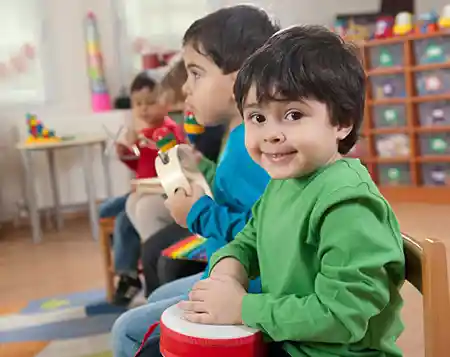First This, Then That: Using Now/Next Boards

First This, Then That: Using Now/Next Boards to Support Transitions
For young children, transitions can be tough. Moving from one activity to the next (especially if it's something they’re not excited about) can lead to confusion, resistance, or frustration. While the concept might seem too simple to be a genuine support, Now/Next boards are a helpful addition to any educator’s collection of resources. A Now/Next board is a simple visual that shows two steps: what’s happening now and what’s coming next. These are often used in partnership with a visual schedule to support transitions and help children understand the flow of the day.
A Visual That Makes Sense
Also called First/Then boards, these simple visual tools help children understand what’s happening now and what will happen next. They offer a predictable structure that supports communication, builds independence, and reduces anxiety throughout the day.
It’s as straightforward as it sounds: Now shows the current activity, and Next shows what will follow. You can use photos, picture symbols, or even real objects...whatever works best for the children in your classroom community. These boards can be static (laminated with Velcro) or flexible (drawn on a whiteboard or sticky note).
Clarity Children Can Count On
We’ve all experienced a clean-up time meltdown or the eager but repetitive “Is it lunchtime yet?” Now/Next boards offer clarity and support so that children feel steady and tuned in to their daily rhythm. Here are a few benefits of having one in your classroom toolkit!
- • Promote comfort and predictability around transitions
- • Build independence and understanding of daily routines
- • Support positive behavior by pairing less preferred tasks with more motivating ones
- • Provide an alternative to repeated verbal reminders
- • Create a more responsive classroom environment
From Setup to Success
There’s no one right way to use a Now/Next board, and the beauty is in how flexible it can be. Whether you're introducing it to the whole group or just one child, the goal is the same: help children understand what’s happening and what’s coming next.
While some classrooms use a full visual schedule that outlines the entire day, that format can feel overwhelming, especially for younger children or those who are already feeling dysregulated. A Now/Next board narrows the focus. It breaks the day into smaller, manageable parts and can be used alongside a full schedule. For example, a child might check the class schedule and then use a Now/Next board to zoom in on just the next two steps. This layered approach helps reduce feelings of overwhelm and builds a sense of control.
It’s also important to use the board proactively. While it can be helpful during moments of challenge, it’s most effective when it’s introduced as a consistent tool for understanding, not only as a response to behavior. Over time, children may begin using the board on their own. Some might start pointing to what’s next as a way to prepare themselves. Others might enjoy helping to set it up. That sense of ownership can be especially powerful when the upcoming activity isn’t one they’re excited about. Choosing to engage with the tool gives them agency during moments that might otherwise feel hard.
Here are a few tips to get you started:
- • Keep it Visual: Use clear images, symbols, or photos that the children understand. You might even take photos of your class during transitions and different times of the day to use for your board.
- • Pair Tasks Strategically: Start with something simple or neutral in the “Now” spot and follow it with something motivating in the “Next” spot.
- • Minimize Verbal Prompts: Once you and your children are accustomed to this resource, just point to the steps instead of repeating instructions. Use short, consistent language like “First this, then that.”
- • Follow Through: Be consistent. If the board shows snack is next, make sure snack really is next. This builds trust and understanding.
- • Keep It Visible: Post the board at children’s eye level and refer to it often. You might even choose to make a portable version. Some children may check it multiple times for reassurance.
- • Adjust Support Over Time: As children become familiar with the tool, they may be able to help create or manage it themselves.
Make It Work For You
You might already use a Now/Next board every year with every class, or maybe you tried it once and didn’t feel much of a shift. Some educators lean on it during the first few weeks of school, then set it aside once routines are solid. Others keep one nearby year-round for children who benefit from a little extra structure. Like any strategy, its value comes from how and when it’s used. The most important thing is to stay responsive. If a simple visual helps a child feel more confident, calm, and ready to move through their day, it’s worth keeping close.
Looking to give it a try or refresh what you’re already using? Check out Becker’s customizable Now/Next Board with Daily Schedule Cards to create a version that works for your classroom.
Resources
Now/Next Board with Daily Schedule Cards
Becker’s Early Childhood Classroom Visual Resources

Christine Murray is an Early Childhood Education Specialist with Becker’s Education Team.
As an educator, coach and leader, Christine is inspired by the curiosity, joy and wonder that children so generously model for us. She earned her M.A. in Innovative Early Childhood Education at the University of Colorado Denver and loves collaborating with and supporting others in the field. Grounded in relationships and guided by empathy, Christine is always learning, connecting and creating.
